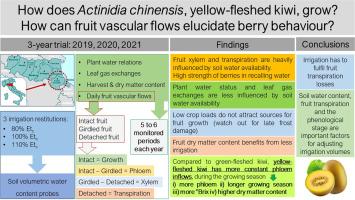Fruit vascular flows in yellow-fleshed kiwi reveal tight relations between water availability and fruit growth potential, until harvest
IF 4.2
2区 农林科学
Q1 HORTICULTURE
引用次数: 0
Abstract
Yellow-fleshed kiwifruit production guidelines normally follow protocols based on the green-fleshed species, A. deliciosa, often resulting in low yields, reduced dry matter and small fruit size, as A. chinensis seems more susceptible to water limitations. Clarifying this species fruit vascular flows may help improve yields, and fruit size, by satisfactorily meeting its irrigation needs. This 3-year trial (2019–2021) compared 100 % with deficit-irrigated and over-irrigated vines. Plant water relations, leaf gas exchanges and fruit vascular flows were measured at midday during the season, and fruit were harvested and assessed for dry matter content. Irrigation influenced vine responses only when soil water content dropped below 25–30 %, reflecting the sensitivity of this crop to soil water changes. Although no differences were found for yield, dry matter content was higher for the least irrigated fruit, but overall vine performance in this treatment was limited throughout the study, in particular during the rapid growth phase (e.g., ca 1 month after full bloom), when very high fruit transpiration rates energize passive phloem unloading, to support fruit parenchyma cell division and expansion. Unlike A. deliciosa, A. chinensis appears to maintain fruit transpiration and associated phloem unloading later into the season. The symplasmic unloading in the early stages of berry development reveals a strong effect on fruit development by its microenvironment, thus irrigation must be carefully gauged to the needs of developing fruit, accounting for soil water content and the phenological phase. Plant and environmental sensors are quite important for determining the necessary water volumes for yellow-fleshed kiwifruit.

黄肉猕猴桃果实维管流动揭示了水分有效性和果实生长潜力之间的密切关系,直至收获
黄肉猕猴桃的生产指南通常遵循基于绿肉猕猴桃品种A. deliciosa的协议,通常导致产量低,干物质减少,果实尺寸小,因为A. chinensis似乎更容易受到水分限制。澄清该物种的果实维管流动可以通过满足其灌溉需求来帮助提高产量和果实大小。这项为期3年的试验(2019-2021年)100%与亏水灌溉和过度灌溉的葡萄藤进行了比较。植物水分关系、叶片气体交换和果实维管流动在季节中午测量,果实收获并评估干物质含量。只有当土壤含水量低于25 - 30%时,灌溉才会影响葡萄的反应,这反映了该作物对土壤水分变化的敏感性。尽管在产量上没有发现差异,但干物质含量在灌溉最少的果实中较高,但在整个研究过程中,这种处理的葡萄整体表现有限,特别是在快速生长期(例如,开花后约1个月),这时非常高的果实蒸腾速率激发了韧皮部的被动卸载,以支持果实薄壁细胞的分裂和膨胀。与美味草不同,中国草似乎能维持果实蒸腾和相关韧皮部在季节后期的卸载。浆果发育早期的辛质卸载对果实发育有强烈的微环境影响,因此灌溉必须根据果实发育的需要,考虑土壤含水量和物候期。植物和环境传感器对于确定黄肉猕猴桃所需的水量非常重要。
本文章由计算机程序翻译,如有差异,请以英文原文为准。
求助全文
约1分钟内获得全文
求助全文
来源期刊

Scientia Horticulturae
农林科学-园艺
CiteScore
8.60
自引率
4.70%
发文量
796
审稿时长
47 days
期刊介绍:
Scientia Horticulturae is an international journal publishing research related to horticultural crops. Articles in the journal deal with open or protected production of vegetables, fruits, edible fungi and ornamentals under temperate, subtropical and tropical conditions. Papers in related areas (biochemistry, micropropagation, soil science, plant breeding, plant physiology, phytopathology, etc.) are considered, if they contain information of direct significance to horticulture. Papers on the technical aspects of horticulture (engineering, crop processing, storage, transport etc.) are accepted for publication only if they relate directly to the living product. In the case of plantation crops, those yielding a product that may be used fresh (e.g. tropical vegetables, citrus, bananas, and other fruits) will be considered, while those papers describing the processing of the product (e.g. rubber, tobacco, and quinine) will not. The scope of the journal includes all horticultural crops but does not include speciality crops such as, medicinal crops or forestry crops, such as bamboo. Basic molecular studies without any direct application in horticulture will not be considered for this journal.
 求助内容:
求助内容: 应助结果提醒方式:
应助结果提醒方式:


